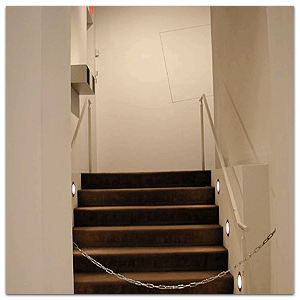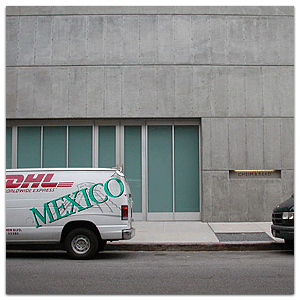
My favorite neighborhood in New York is the rarified art gallery playland of West Chelsea. Built from largely abandoned warehouses from 1996 to 1999, approximately 190 white box galleries are clustered like an outrageous case of shingles along the west hip of Manhattan. I love to spend a sunny afternoon roaming the galleries with the upper classes, watching videos that in any other environment surely would be called pornography. I crave being surprised in a gallery by something thrilling: an epic homoerotic painting of sailors shaving each other, say, or a blinking, flashing, and ultimately inexplicable interactive doohickey machine. Best of all, it’s free to look, if not to take home.
I also adore marveling like a hayseed at the outrageous prices. Perhaps it’s the last vestige of growing up in a trailer, but even after a decade in New York I’m still amazed that we live like this, that people plunk down forty thousand dollars for a painting by someone who only a few hundred people have heard of. What could be more fantastic?
Wanting to convince my friend Jacob of the value in the mad and majestic Chelsea lifestyle, I persuaded him to meet me for a drink at the Half King, Sebastian Junger’s bar on West 23rd Street. It was the day after the smoking ban, and after an endless, oxygenated evening of bars the night before, the lack of ashtrays made me pissy all over again. Jacob slammed back a Guinness for fortification, and together we limped away—he was recovering from a recent knee surgery.
I was nervous about our expedition to the galleries. Jacob, the twenty-something Internet entrepreneur, openly admits to hating art. Far beyond simple suspicion and fear, his deep-seated rancor at the insularity of high-falutin’ fine art knows no limits. He puts his faith in what we might call the practical arts: rock music, computer code, the love of a good woman. My fear was that, confronted with anything referred to as a ‘conceptual allegory,’ he could snap, possibly even kill. Given his considerable financial means, my secret goal was to have him fall in love with art and purchase massive quantities of it.
Our first stop was Paula Cooper, probably my favorite Chelsea gallery. Designed to look like a deserted airplane hanger, or a stage where the visitor is the only actor, the gallery’s slick concrete floors and the distant rough timbers of the ceiling pleasantly dwarf the art. One could hang out there undisturbed for hours, alternately directing focus to the carefully-wrought art and then allowing the empty mass of architecture to become a Zen-ly white noise.
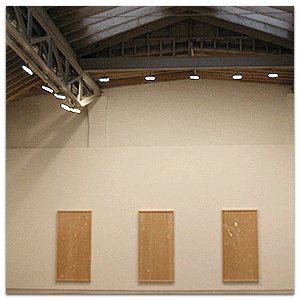
Jacob staggered in. ‘Take a picture of those,’ he whispered to me, pointing at some gold-dipped cow skulls near the entrance, ‘My friend’s band uses that as their logo.’ Victory! He was engaged. But as we wandered in to the main gallery, my heart dropped.
Instead of a grand and moving installation of a reconstructed tree or a Watts Tower of half-filled plastic bottles, the gallery seemed parodic: on view was an array of 12 sheets of framed plywood with their knotholes carefully puttied in. I felt as though someone had stolen the last clean pair of socks from my drawer. Normally I would expect simple means used to great effect, here at the home of haute conceptualism; this was almost no means to less than zero effect. Could I be such a liar as to convince Jacob to love art such as this? I smiled queasily at him. He seemed undisturbed—his low expectations were unrocked. Obviously, he’d been to a lumberyard before: plywood required no explanation. I pulled him outside quickly while a fluttering depression began to take hold.
We pressed on to 24th Street and nipped into the first gallery we found. On the walls of the slick and fluorescent-lit garage were photographs of what Jacob presumed to be real people adjusting the postures of people with Down’s Syndrome. Two young women in cheap slingbacks stared raptly at one of the six-foot photos, as if it were a movie or a brainwashing device. Checking the press material as we left, we learned that the people we thought were ‘special’ were, in fact, fake: the subjects were life-like sculptures made by another well-known artist. I began to panic.
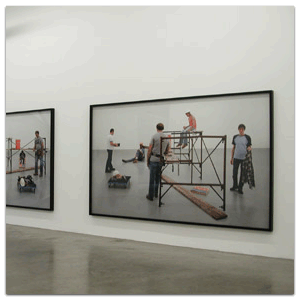
Those photographs weren’t good and I’ll tell you why: any possible feeling generated by their subjects would be a fraud. A photograph whose premise is that some of the people in it aren’t actually people is certainly interesting. But when that premise isn’t intelligible because the photograph is easily mistaken for a rather Harmony Korine-esque mockery of the retarded, then that photograph is so unintentionally insipid as to have no meaning whatsoever. Plus, the insider-art jokery of a well-known artist photographing another artist’s sculptures is exactly why people like Jacob will never care about the art world.
The drawing show at the gallery next door was comprised of pencil scribblings, work that looked as if it had been made by starved vegan schoolchildren, deprived of sunlight, meat, and love. Drifting from one to the next, we were both briefly attracted to a graph-like drawing of personal ads that struggled with the idea of being good. But then Jacob saw a ridiculous caveman scrawling next to it. He pointed and laughed mockingly. And I, I laughed too.
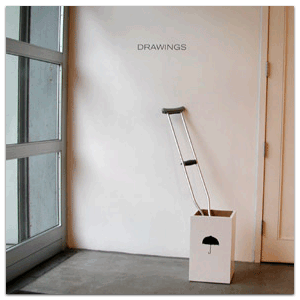
I had set out to convert Jacob to the love of art, and instead his easy disdain was converting me. I began to apologize for the expedition, the art, even myself. He shrugged, unharmed by the disregard of art, something he didn’t even care for. Frantically I dragged him into the next gallery, then the next. Globby paintings of sunsets (but why sunsets? who cares?), repetitive time-and-date-stamped snapshots of a naked man bathing in streams (I can’t imagine why I’d care about someone’s vacation nudism, unless there’s a hard-on involved), and empty, crappily painted flowery canvasses of a gender-indeterminate couple on what appeared to be the set of Six Feet Under. I stood in the middle of the empty Mary Boone gallery, the most pristine money mill in the world, surrounded by a sold-out show of half-a-million dollar paintings. The impeccable staff were clicking their pens and answering their phones and I wanted to scream.
Had it always been so awful? On other trips to Chelsea I have seen art that I loved: faked photographs of terrorists attacking Manhattan apartment buildings that pissed me off and then grew on me, goofy comic drawings of bespectacled children in Hell’s library that made me laugh. But that was at smaller, chancier galleries. It occurred to me then that in the past I had only attended the big-name galleries for the aura, for the stench of money, the fashion on the staff, a glimpse of a FedEx package at the front desk bound for the Upper East Side. I went because, beneath my anarchist veneer, I had really believed the business was a meritocracy, where most expensive meant best. I loved the slick pornography of it all: the skylights, the assistant’s assistants, the floor-to-ceiling windows. Foremost, I loved the square footage.
In the midst of my breakdown, we took refuge at Pace Wildenstein on 25th Street. I wouldn’t look at the Elizabeth Murray paintings on view, because I love her so, and what if the paintings turned out to be secretly, openly bad along with everything else in that accursed neighborhood? I couldn’t live with that, so I kept my eyes on the floor. In a back office of the gallery, behind a chain and up some stairs, Jacob spotted a small double box, like a minimalist bookshelf, protruding from the wall. It was the first thing he had liked all day, he said. I carefully peeled back a few of my fingers for a good view. It was by Donald Judd, I told him, and given recent auction results, it probably went for upwards of eighty thousand dollars. Jacob chuckled and lost interest. I looked at it again. It was just a fucking box on the wall. Eighty thousand dollars. Ridiculously, I wanted to cry.
